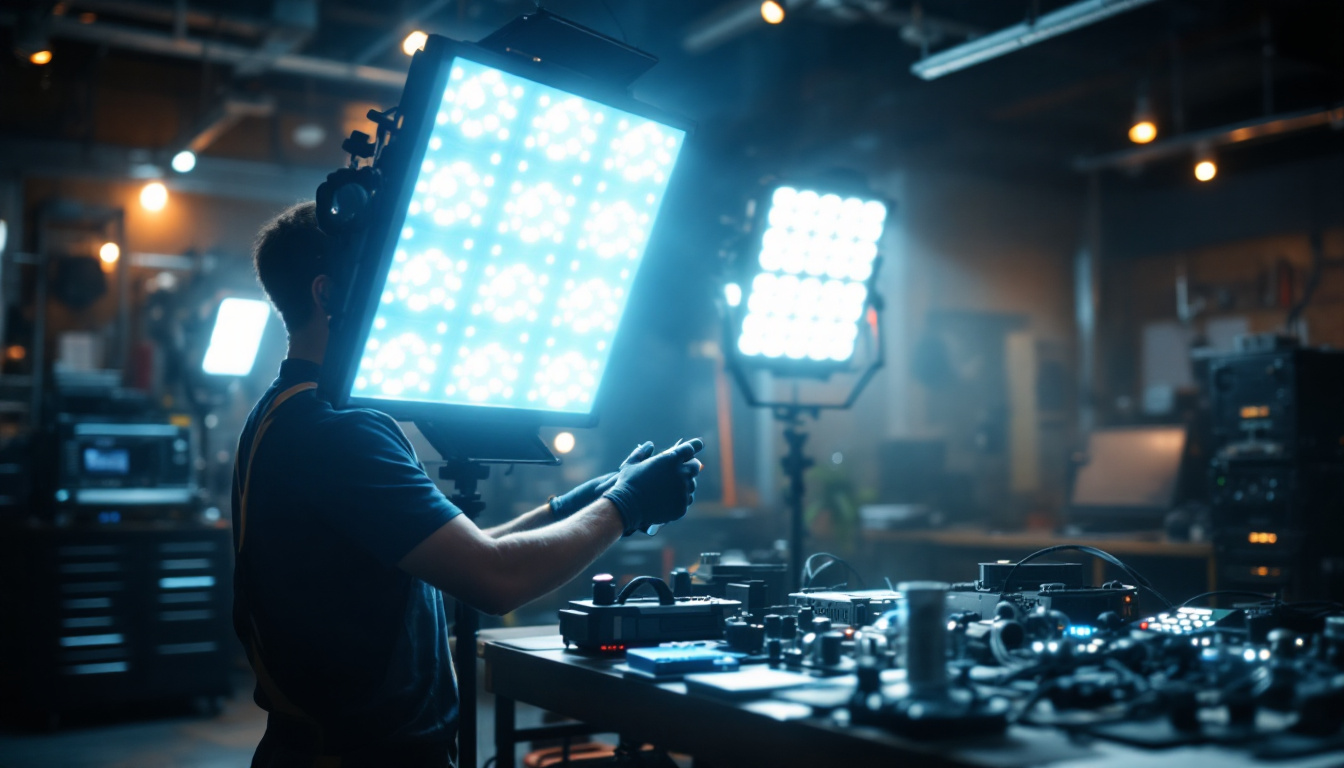

In the ever-evolving world of lighting technology, LED industrial lighting stands out as a transformative force. As lighting contractors seek to enhance their skills and knowledge, understanding the nuances of LED technology becomes paramount. This article delves into the top resources available for lighting contractors aiming to master LED industrial lighting, from technical specifications to design principles and installation techniques.
LED, or Light Emitting Diode, technology has revolutionized the way industrial lighting is approached. Unlike traditional lighting solutions, LEDs offer significant advantages in terms of energy efficiency, longevity, and versatility. For lighting contractors, a deep understanding of how LEDs work is essential to leverage their benefits effectively.
At its core, an LED operates by passing an electric current through a semiconductor material, which emits light. This process is known as electroluminescence. Unlike incandescent bulbs, which generate light through heat, LEDs produce minimal heat, making them more efficient and safer for various applications.
Understanding the technical specifications of LEDs, such as lumen output, color temperature, and wattage, is crucial for contractors. These metrics not only affect the quality of light produced but also influence energy consumption and operational costs.
LED industrial lighting offers numerous advantages that make it a preferred choice for contractors. One of the most significant benefits is energy efficiency. LEDs consume significantly less power compared to traditional lighting solutions, leading to reduced electricity bills and a smaller carbon footprint.
Moreover, the longevity of LEDs is a game-changer. With lifespans often exceeding 50,000 hours, they require less frequent replacements, which translates to lower maintenance costs and less downtime in industrial settings. This durability also means that LEDs can withstand harsh conditions, making them suitable for various environments.
Mastering LED industrial lighting requires access to reliable resources. From online courses to industry publications, contractors can enhance their knowledge and skills through various platforms. Here are some of the top resources available:
Many organizations offer online courses tailored specifically for lighting contractors. These courses often cover a range of topics, including LED technology fundamentals, lighting design principles, and installation best practices. Some reputable platforms provide certifications that can enhance a contractor’s credibility and marketability.
Investing time in these courses not only fosters a deeper understanding of LED systems but also keeps contractors updated on the latest industry trends and technologies. Additionally, many courses feature hands-on projects that allow contractors to apply their knowledge in real-world scenarios.
Staying informed about the latest developments in the lighting industry is crucial for contractors. Industry publications and journals provide valuable insights into new technologies, case studies, and best practices. Subscribing to reputable lighting magazines or journals can help contractors stay ahead of the curve.
Many publications also feature articles written by industry experts, offering practical advice and innovative solutions to common challenges faced by lighting contractors. Engaging with these resources can inspire new ideas and approaches to projects.
Participating in webinars and workshops is another effective way for lighting contractors to expand their knowledge. These events often feature expert speakers who share their insights on various topics related to LED industrial lighting. They provide opportunities for contractors to ask questions and engage in discussions with peers.
Many organizations host regular webinars that focus on specific aspects of LED technology, such as design considerations, energy efficiency, and installation techniques. These interactive sessions can be invaluable for contractors looking to deepen their understanding and network with other professionals in the field.
Designing effective LED industrial lighting systems requires a solid grasp of design principles. Lighting contractors must consider factors such as illumination levels, color rendering, and energy efficiency when creating lighting layouts. Here are some essential design principles to keep in mind:
Determining the appropriate illumination levels for a given space is critical. Different industrial environments have varying lighting requirements based on the tasks performed. For instance, a warehouse may require different levels of brightness compared to a manufacturing facility.
Contractors should refer to industry standards and guidelines to establish optimal illumination levels. This ensures that the lighting not only meets safety regulations but also enhances productivity and comfort for workers.
Color rendering is another vital aspect of LED lighting design. The Color Rendering Index (CRI) measures how accurately a light source displays colors compared to natural light. A higher CRI indicates better color accuracy, which is especially important in environments where color differentiation is crucial, such as in quality control processes.
When selecting LED fixtures, contractors should consider the CRI rating to ensure that the lighting meets the specific needs of the workspace. This attention to detail can significantly impact the overall effectiveness of the lighting system.
Energy efficiency is a fundamental principle in modern lighting design. As energy costs continue to rise, contractors must prioritize solutions that minimize energy consumption while maintaining optimal lighting performance. LED technology inherently offers energy savings, but additional measures can further enhance efficiency.
Implementing smart lighting controls, such as occupancy sensors and dimming systems, can significantly reduce energy usage. These technologies allow lighting to adapt to real-time conditions, ensuring that lights are only on when needed. By integrating these solutions, contractors can provide clients with sustainable and cost-effective lighting systems.
Once the design phase is complete, the next step is installation. Proper installation techniques are crucial for ensuring that LED lighting systems operate efficiently and effectively. Here are some key installation considerations for lighting contractors:
LED fixtures often have specific electrical requirements that differ from traditional lighting systems. Contractors must familiarize themselves with voltage, wattage, and compatibility with existing electrical infrastructure. This knowledge is essential for ensuring that installations comply with safety standards and function optimally.
Moreover, understanding the electrical load of the lighting system is critical to prevent overloading circuits. Proper planning and calculations can help contractors avoid common pitfalls during installation.
The placement and mounting of LED fixtures play a significant role in achieving desired lighting outcomes. Contractors should consider factors such as beam angle, height, and spacing when positioning fixtures. Proper placement ensures even distribution of light and minimizes shadows, enhancing the overall effectiveness of the lighting system.
Additionally, contractors should be aware of any mounting requirements specific to the fixtures being used. Following manufacturer guidelines for installation helps ensure that the fixtures perform as intended and maintain their longevity.
After installation, thorough testing and commissioning are essential to verify that the lighting system meets design specifications. This process involves checking illumination levels, verifying functionality, and ensuring that all controls operate as intended.
Contractors should conduct a comprehensive walkthrough of the installation site, making adjustments as necessary to optimize performance. This final step not only ensures client satisfaction but also reinforces the contractor’s reputation for quality work.
The landscape of LED industrial lighting is continually evolving, driven by advancements in technology and changing industry demands. Staying informed about future trends can help contractors remain competitive and offer cutting-edge solutions to their clients. Here are some emerging trends to watch:
Smart lighting systems are gaining traction in industrial settings, offering enhanced control and automation. These systems utilize IoT (Internet of Things) technology to enable remote monitoring and management of lighting fixtures. Contractors should familiarize themselves with smart lighting solutions, as they provide clients with increased flexibility and energy savings.
Integrating smart technology into lighting systems allows for features such as scheduling, dimming, and occupancy sensing. This not only improves energy efficiency but also enhances user experience, making it a valuable selling point for contractors.
Human-centric lighting focuses on creating lighting environments that support human well-being and productivity. This approach considers factors such as color temperature and intensity, aiming to mimic natural light patterns. As awareness of the impact of lighting on health grows, contractors should explore human-centric design principles to meet client demands.
Implementing these principles involves understanding circadian rhythms and how lighting can influence mood and performance. By offering human-centric solutions, contractors can differentiate themselves in a competitive market.
Continuous advancements in LED technology are leading to improved efficiency, color rendering, and customization options. Contractors should stay informed about the latest innovations, such as tunable white LEDs and advanced optics, which can enhance lighting design possibilities.
By embracing new technologies and staying ahead of industry trends, contractors can offer clients innovative solutions that meet their evolving needs. This proactive approach not only strengthens client relationships but also positions contractors as leaders in the field.
Mastering LED industrial lighting is a multifaceted endeavor that requires a combination of technical knowledge, design principles, and installation expertise. By leveraging the resources available, including online courses, industry publications, and workshops, lighting contractors can enhance their skills and stay competitive in the market.
Understanding the fundamentals of LED technology, applying effective design principles, and employing proper installation techniques are all critical components of successful projects. As the industry continues to evolve, staying informed about future trends will empower contractors to provide innovative solutions that meet the needs of their clients.
In an era where energy efficiency and sustainability are paramount, mastering LED industrial lighting is not just an option; it is a necessity for lighting contractors aiming to thrive in the industry. By embracing this knowledge and continuously seeking to improve, contractors can illuminate the path to success.
Ready to take your LED industrial lighting projects to the next level? At LumenWholesale, we provide lighting contractors with the resources they need to shine. Our spec-grade lighting products not only meet the highest industry standards but also come at unbeatable wholesale prices, giving you the edge in both quality and cost. Say goodbye to middleman markups and hello to hassle-free bulk buying with free shipping. Elevate your lighting solutions and enhance your competitive advantage with Wholesale Lighting at the Best Value from LumenWholesale. Your path to success in LED industrial lighting starts here.

Discover innovative cost-saving strategies for lighting contractors with LED motion sensor lights.

Discover the hidden pitfalls of purchasing electrical supplies and mounting kits in bulk from local distributors.

Discover the benefits of solar LED garden lights in this comprehensive guide.

Discover how innovative light bulbs are transforming the landscape for lighting contractors.
Get notified when NEW deals are released.
Optimize your budget with wholesale discounts.
Only top-quality, specification-grade lighting products.
No additional costs at checkout - what you see is what you pay.
We understand the unique needs of contractors.